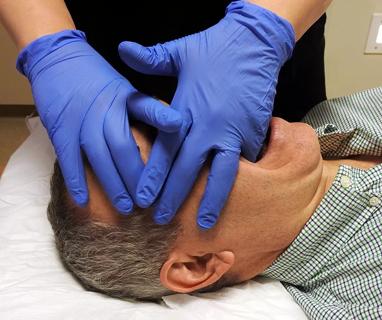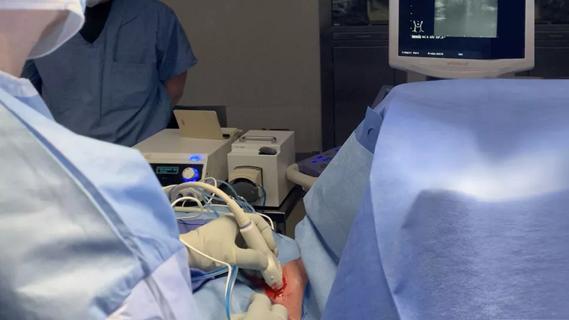Dynamic risk assessment may aid clinicians in helping support informed treatment decisions

A new approach to risk stratification in patients with the tall cell variant (TCV) of papillary thyroid cancer (PTC) could help to inform patient counseling, management and surveillance for this particularly aggressive PTC subtype, Cleveland Clinic researchers have found.
Advertisement
Cleveland Clinic is a non-profit academic medical center. Advertising on our site helps support our mission. We do not endorse non-Cleveland Clinic products or services. Policy
The TCV is typically associated with higher recurrence and greater mortality compared with classical PTC. But outcomes aren’t uniformly poor. Among 94 patients with TCV who underwent total thyroidectomy (TT) with radioactive iodine (RAI) ablation at Cleveland Clinic from 1998 through 2020, those who had excellent overall responses to treatment had significantly lower recurrence and mortality rates compared to those with indeterminate or incomplete responses.
Currently, the American Thyroid Association (ATA) risk stratification for differentiated thyroid cancer relies on baseline tumor and patient characteristics to predict recurrence and persistent disease. In contrast, dynamic risk assessment (DRS) incorporates post-operative thyroglobulin, physical exam and imaging findings to further assist in determining next steps for individual patients.
“Traditionally in many cancers we focus on the beginning for prognostic information based on pathologic findings from the case and what’s going on at the time, but we haven’t focused on the response to treatment,” says lead author Joseph Scharpf, MD, Director of Head and Neck Endocrine Surgery at Cleveland Clinic. “When you start to look at that, it’s probably better in giving you more clarity on how a patient is expected to do.”
The DRS approach was pioneered for use in PTC by R. Michael Tuttle, MD, at Memorial Sloan Kettering Cancer Center, New York. “This Cleveland Clinic investigation is the first to evaluate DRS in patients with aggressive histologic variants such as TCV,” Dr. Scharpf says.
Advertisement
At baseline, all 94 of the Cleveland Clinic patients were classified as ATA intermediate or high risk. After TT+RAI, 84.9% (n=79) patients had a complete structural response, 60.9% (n=56) had an excellent biochemical response and 55.4% (n=51) had an excellent overall response. Responses were biochemically incomplete in 10.9% (n=10), structurally incomplete in 7.6% (n=7) and overall indeterminate in 26.1% (n=24).
The patients with an excellent overall response to therapy had lower rates of locoregional recurrence at five years compared to those with indeterminate, biochemical incomplete, and structural incomplete responses (2.0%, 33.3%, 55.0% and 85.7% respectively, p<0.001). The same was also true for 5-year distant recurrence (2.0%, 9.0%, 35.1%, and 42.9%, p<0.001).
Biochemical and overall response to therapy also predicted disease-specific mortality (P=0.007 and p<0.001, respectively), whereas structural response did not (P=0.55).
Only one (2.0%) of the 51 patients with an excellent overall response to therapy died due to the cancer, compared with 14.3% with structurally incomplete and 40% with biochemically incomplete responses.
None of those with excellent overall responses required additional interventions such as more RAI, reoperation, chemotherapy or radiation. In contrast, such measures were needed for 6 of 10 of patients with biochemical incomplete, 7 of 7 with structural incomplete and 14 of 24 with indeterminate response.
The DRS approach could assist in counseling patients. “The diagnosis certainly creates a lot of fear,” says Dr. Scharpf. “This way, we can set up their expectations that what may be most important is how their markers are looking six months to a year after the surgery, rather than just what we’re telling them right now. We might say right up front that this is a more aggressive cancer and may carry a worse prognosis, but that by six months or a year if we haven’t seen any worrisome markers then they may be in a different category.”
Advertisement
The findings may also influence post-surgical surveillance, in that “if the patient has very good results for a period of time, then maybe we don’t need to do further ultrasound or other studies,” he says.
And for the patients with sub-optimal responses to treatment, a second procedure to remove further cancerous tissue also presents an opportunity to send the sample out for molecular testing to see if the patient may be eligible for targeted therapy. “If you see certain patients who aren’t going to do well, you could be more aggressive by collecting tissue from them,” Dr. Scharpf says. “Molecular testing hasn’t been done traditionally, but now these targeted drugs have exploded. For an individual who has one of the molecular targets it’s a game-changer.”
At Cleveland Clinic’s Lerner College of Medicine’s Head & Neck Surgery department, all patients with PTC are seen in clinic by staff from surgery, radiation oncology, medical oncology, endocrinology, pathology and radiology. Members of those teams all contributed to this research.
“We have separate multidisciplinary tumor boards for thyroid as well as head and neck cancers. We’ve found that the best outcomes have come from this approach.”
Advertisement
Advertisement

Studies find mTOR inhibitor may play key role in treating Hurthle cell carcinoma

OMT may be right for some with Graves’ eye disease

A new study indicates that the combined approaches can be performed without mortality and with acceptable morbidity

New research provides clinical insight into prognostic factors

Struma ovarii can give rise to uncommon malignancy

Only 33% of patients have long-term improvement after treatment

Strong communication with the patient and a thorough approach are essential

Radiofrequency ablation significantly reduces symptom severity, shrinks nodules